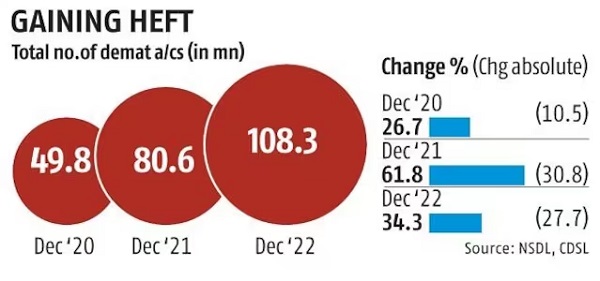Explore why investors need to be more educated in the new age of investing, with insights on emerging sectors and the shift away from short-term gains.
In the last two and half years India has added around 2.5 cr new demat account holders who are doing investments in the Indian equity market. Well, the definition of DIIs has changed dramatically in the last couple of years. Nearly 28 million demat accounts were added in 2022. This turns out to be a growth of 34.3 per cent, which was lower than that of 2021 which stood at 61.8 per cent. All this means that new investors are coming up and the market is getting significant inflows into the capital market. Currently, the Equity investment of Indian households stands to be 4.8% which was just 2% in the year 2019-2020. This number will increase in coming years but will in the investor community make returns unless they invest time and do not chase short-term gains. Before we get into the prime objective of the article will like to accentuate a few key areas of Indian industries for the coming few years.

India has come up with a PLI scheme where the ministry of finance has announced an outlay of INR 1.97 Lakh Crores for the Production Linked Incentive (PLI) Schemes across 14 key sectors. This will bring in many new companies in the coming years towards this segment.
India is on the path of becoming Atmanirbharta in Defense and hence many manufacturing companies will come up and will hit the primary and secondary markets in coming years. The Indian government has set the defence production target at US$ 25.00 billion by 2025 (including US$ 5 billion from exports by 2025). India is one of the world’s biggest defence spenders with a total outlay of Rs. 5.25 lakh crore (US$ 66 billion), accounting for 13.31% of the total budget and indicating an increase over the budget estimates of 2021-22 by Rs. 46,970 crore (US$ 5.9 billion).
For example, the government has allocated Rs 7,000-cr PLI boost for toys, and bicycle components which will be coming soon. Now there will be many companies which will get listed in the market seeking access to capital. On the other hand, the Centre is expected to launch an updated version of its production-linked incentive (PLI) scheme for IT hardware soon and could increase the overall outlay for the scheme to around Rs 20,000 crore
Once the EV gets a market share of 15% or 20% in the coming next 3 to 5 years of the Automobile industry we will find many manufacturing companies hitting the market to raise capital and become a market leaders. Similarly, even the charging infrastructure will breed many manufacturing industries to hit the capital market.
India is speaking on carbon emissions and alternative energy sources like Hydrogen. Similarly, many companies will come up and will raise either debt or equity from the market. In short, huge opportunities are coming up for investors to invest in India. But the biggest question is that does the investors are capable enough to understand these new industries and companies which will be getting listed in the coming next 5 years. Yes, this key is where investors will lose out since only chasing short-term returns will not make wealth when global conditions are going remain volatile. Identification of quality companies and products is the work of fund managers. Well, Fund Managers come into that place where one doe investments in Mutual Funds, PMs or AIF but what about the direct equity investors?
It has been observed that chasing returns and quick money has become a notion for the investor investing in the market. We often speak of income inequality which also leads to wealth inequality. In India, it is found that 88% of India’s ultra-high net worth individuals or UHNI have reported growth in their wealth. The prime reason for this high wealth creation is that they understand where they have to invest and in which company/sector or market. This segment of society doesn’t look for shortcuts but for real investment themes. Whereas the rest of the segment of the people in society invest for the short term and follow the herd mentality while doing investments.

Do we investors have the ability to understand the new age companies and their functions and profitability matrix? Do we investors spend time learning about these innovations and companies? Well, investment is going to become tough in the coming years particularly in the equity space since the broader segment of many new industries and ancillary industries will grow significantly as compared to what we have now.
It has been found that investors who do investment in structure products like PMS and AIF also follow the same herd mentality and mostly chase the returns. Many reputable wealth companies and banks are selling PMS and AIF showing past performance. The most shocking thing is that investors are HNI levels are also investing based on past returns and particularly based on the last 2 years’ magic returns number from those products.
Investor’s education needs to move ahead from the traditional matrix to the new age ones where upcoming sectors/stocks/companies need to explain moving away from explaining Asian paints and Reliance Industries. For investing in structured products also one needs to have a good understanding of the various dynamics of the PMS or AIF and its objectives. In many cases, it has been found that investors who have invested in PMS or AIF are focusing more on withdrawals in the short term since the products were sold on the last 2 years’ magical returns.
Investors would have the ability to understand these new-age companies/industries and products before investing. Only chasing the listing gains and grey market premium will not lead to wealth creation. The challenges for investing can only be resolved through significant knowledge of these upcoming business models irrespective of service or manufacturing industry. The investor education segment needs significant changes where the primitive syllabus now needs to move into an advanced stage uplifting the knowledge beyond the basic of investing and compounding.





